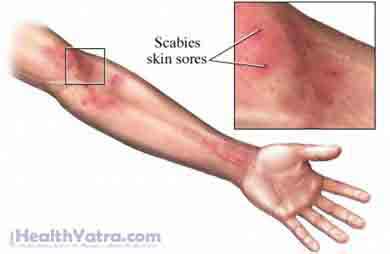Definition
Scabies is an infestation of the skin. It is caused by a tiny mite.

Causes
An infestation results when the female mite burrows into the skin and lays its eggs. The scabies mite does not suck blood. It does not transmit any disease other than scabies between people.
Scabies is highly contagious. Most often, it is passed from person to person through:
- Close and generally prolonged physical contact
- Sexual contact
Scabies can also spread from person to person by sharing:
- Clothing
- Towels
- Bedding
Scabies can occasionally also be acquired from certain mammals. It is most common from dogs with sarcoptic mange. Scabies from dogs differs somewhat from human scabies. It rarely passes from person to person.
Risk Factors
Factors that increase your chance of scabies include:
- Age: less than 15 years, or older than 65 years
- Sexual contact with new or multiple partners
- Close, physical contact with a person who has scabies
- Living in close quarters with others (such as in a nursing home or military barracks)
- A weakened immune system
- Close contact with animal scabies
Symptoms
Symptoms of scabies include:
- Intense itching, usually worse at night
- Small red bumps, pimples, or lines on the skin
In more severe cases, the infested area may:
- Appear crusty
- Become infected and discharge pus
Scabies rarely affects the face or head. While any other body area, or even the whole body, may be involved, areas most often affected include:
- Hands, especially between the fingers
- Wrists and elbows
- Feet
- Genitals and pubic area (especially in men)
- Buttocks
- Around the nipples (especially in women)
- Waistline
- Bellybutton and lower abdomen
- Areas where clothing is tight
- Under rings, watches, or jewelry
Diagnosis
The doctor will ask about symptoms and medical history. A physical exam will be done. While scabies can often be diagnosed based on these steps, the doctor may scrape some skin off. The sample is examined under a microscope to confirm the diagnosis.
Treatment
It is essential to remove scabies from the living environment to avoid re-infestation after treatment. All bedding and clothing must be thoroughly laundered. Other members of the household or institution should be treated.
Permethrin Cream 5%
Scabies is usually treated by applying permethrin cream 5%. It is applied to the skin from the neck down. The cream is left on for 8-12 hours, usually overnight. Excessive use of this medicine can be harmful, especially in infants. Carefully read and follow the directions. It is best not to repeat treatments unless told to do so by a doctor.
If new, itchy bumps continue to appear in the days following your treatment, be sure to alert your doctor.
Itch Relief
It may take several weeks for itching to disappear following successful treatment. Itching can be temporarily relieved with:
- Antihistamine
- Corticosteroid cream (Lotrisone)
- Antihistamines and corticosteroids
Alternative Medications
Some severe cases may respond poorly to other treatments. In this case, an oral medicine, called ivermectin (Stromectol), is sometimes prescribed. It is given as a single dose that must be repeated after one week.
Alternative topical creams include crotamiton 10% (Eurax) and lindane 1%.
Lindane is a second-line treatment. It should only be given to patients who are unable to take other medicines or who have not responded to them. Lindane can be toxic. It should not be overused. Follow the directions as given.
Prevention
To reduce your risk of getting scabies, avoid close physical contact with anyone who has either scabies or an undiagnosed itchy rash and do not share their:
- Clothing
- Towels
- Bedding
To prevent the spread of scabies from one person to another:
- If you share living quarters with an infected person and/or have close physical contact, consider treatment even if you do not have symptoms.
- Wash or dry clean all clothing, bedding, and towels that may have become infested. Set washing or drying temperatures to 140ºF (60ºC) or more. Mites may live for at least 2-5 days after they leave a human body. They are probably infectious during some or all of that time, especially in room temperatures of 68ºF (20ºC) and above. Some experts suggest that items that cannot easily be cleaned be “quarantined.” This can be done by placing them in a plastic bag for at least three days.
- Try to avoid contact for several days with hard-to-clean or non-cleanable items, like upholstered furniture. Talk to your doctor about ways to deal with household items that cannot be cleaned.
